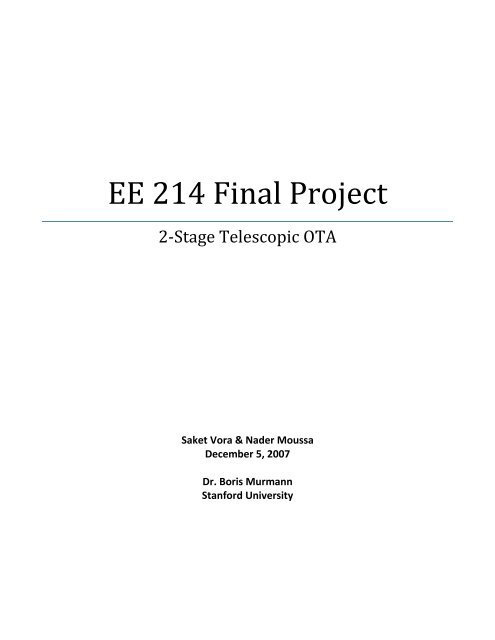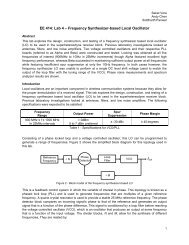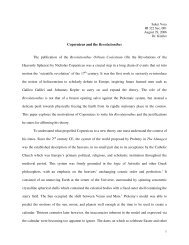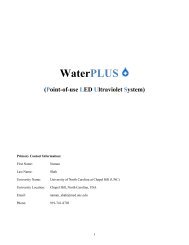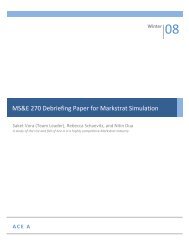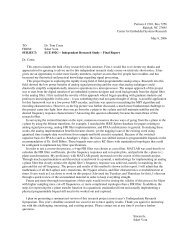EE 214 â Final Project â Fully Differential 2-Stage - Saket Vora
EE 214 â Final Project â Fully Differential 2-Stage - Saket Vora
EE 214 â Final Project â Fully Differential 2-Stage - Saket Vora
You also want an ePaper? Increase the reach of your titles
YUMPU automatically turns print PDFs into web optimized ePapers that Google loves.
<strong>EE</strong> <strong>214</strong> <strong>Final</strong> <strong>Project</strong><br />
2-<strong>Stage</strong> Telescopic OTA<br />
<strong>Saket</strong> <strong>Vora</strong> & Nader Moussa<br />
December 5, 2007<br />
Dr. Boris Murmann<br />
Stanford University
Introduction<br />
A fully differential two stage telescopic operational transconductance amplifier for use in a switched capacitor circuit was<br />
designed using a gm/Id methodology and simulated in HSPICE using a 0.35µm process. This report presents the design<br />
process, optimization efforts, and relevant results including frequency response, transient analysis, noise analysis, and<br />
corner simulations.<br />
The target specifications for the OTA are shown below in Table 1.<br />
V DD Load A V,cl Dynamic Range Settling Time Static Error Dynamic Error<br />
3V ≥ 5pF 1 90 dB ≤ 40ns ≤ 0.025% ≤ 0.025%<br />
Table 1 – Target Specifications for OTA<br />
The feedback and sample capacitors were to be less than or equal to the load capacitor and be equivalent in value to<br />
achieve a unity closed-loop gain. The additional goal was to minimize power. The static error and the dynamic range<br />
requirement drove the selection of a suitable topology. The static settling error ε s is found by<br />
, where T O is the openloop<br />
gain. To achieve less than 0.025% static settling error, an open-loop gain of ≥ 4000 is required. Also a large<br />
differential output V od,peak increases the dynamic range for a given noise power. Thus, a two-stage design consisting of a<br />
high gain first stage and a large swing common-source second stage was selected. Folded cascode and telescopic<br />
configurations were evaluated for the high gain first stage. Both would contribute a gain on the order of , while<br />
the second stage would contribute another . However, a folded cascode has an additional current branch for its<br />
input differential pair, so a telescopic configuration would offer reduced power consumption. The two major weaknesses<br />
for a telescopic configuration – poor input common mode range and low output swing are mitigated by the fact that an<br />
arbitrary input common mode voltage can be specified for this project and the second stage ensures a large output swing<br />
for the overall OTA.<br />
Three variants of this two-stage were designed and simulated: A) PMOS driven telescopic with NMOS driven output stage<br />
utilizing Miller compensation, B) NMOS driven telescopic with PMOS driven output stage utilizing Miller compensation,<br />
and C) NMOS driven telescopic with PMOS driven output stage utilizing an Ahuja-style cascode compensation technique.<br />
Variant A was iterated first, due to the fact that an NMOS driven output stage would have a higher ω T frequency, thus<br />
pole splitting would be achieved more easily. Variant B was iterated on the hypothesis that having NMOS devices in the<br />
first stage signal path would result in smaller device dimensions and transconductances, which would help reduce noise.<br />
Even after MATLAB-based optimization (as described below), both Variant A and B was estimated to have similar drain<br />
currents. Initial results from HSPICE indicated more promise with the NMOS driven telescopic variant, regarding both<br />
dynamic range and power consumption. After Variant B was optimized to minimize power, Variant C was tried as an<br />
exploration of an Ahuja-style cascode compensation as a way to improve the settling time. Inspiration was found by<br />
reading papers from on this technique by Working from the third-order transfer function framework presented in [1] and<br />
[2], a design was iterated with very promising current draw estimates calculated in MATLAB, with nearly all the transistors<br />
operating near or in the sub-threshold region. However, when the design was ported into HSPICE, the circuit’s commonmode<br />
feedback showed sustained oscillations and the open-loop gain was only 75% of the expected value. An analysis of<br />
the tail and output stage bias currents indicated the slew rate was too low as a result of a very small I TAIL . Attempts to<br />
increase common-feedback transconductance and the bias currents to improve the dynamic range and settling-time<br />
resulted in this design consuming a similar and/or greater amount of power compared to the Miller compensated NMOS<br />
telescopic design. Thus, the final topology chosen was Variant B – an NMOS telescopic first stage with a PMOS driven<br />
common-source output stage. While this topology and its associated biasing is simple, for the given specifications it was<br />
found to be very suitable both in minimizing power and for stability concerns.<br />
The gain-boosting technique with a single telescopic stage was not considered because though the high open-loop gain<br />
needed for the static settling error would have been realizable, it was predicted to be difficult to achieve the 90 dB<br />
dynamic range due to the greatly reduced output swing. Additionally, the stability of the gain boosters would also be a<br />
major concern for proper performance.<br />
1
Schematic<br />
Figure 1 shows the telescopic gain stage, the common-source output stage, the CMFB sense and drive components.<br />
V DD V DD V DD<br />
W p<br />
0.50µ<br />
M 4a<br />
Vbc_n<br />
m=3<br />
M 4b<br />
V DD<br />
W p<br />
0.50µ<br />
16.5pF<br />
M 5b<br />
2.54m<br />
0.45µ<br />
16.5pF<br />
M 5a<br />
2.54m<br />
0.45µ<br />
W p<br />
0.50µ<br />
M 3a<br />
Vbc_n<br />
m=3<br />
M 3b<br />
W p<br />
0.50µ<br />
37Ω<br />
R nb<br />
C C,b<br />
37Ω<br />
R na<br />
C C,a<br />
I D1 = 872µA<br />
240 µ<br />
0.35µ<br />
M 2a<br />
Vbc_n<br />
I D1 = 872µA<br />
M 2b<br />
240 µ<br />
0.35µ<br />
I D5<br />
= 1.78mA<br />
V om<br />
V op<br />
Diff<br />
Sense<br />
V od<br />
V oc<br />
V ip<br />
240 µ<br />
0.35µ<br />
M 1a<br />
240 µ<br />
0.35µ<br />
M 1b<br />
V im<br />
I D5<br />
= 1.78mA<br />
m=9<br />
m=7<br />
m=7<br />
I TAIL<br />
W n<br />
M tail 0.35µ<br />
= 1.74mA<br />
g=25<br />
Ideal CFMB Drive<br />
M 6b<br />
W n<br />
0.35µ<br />
M 6a<br />
W n<br />
0.35µ<br />
V oc,desired<br />
m<br />
Figure 2 shows the bias network for the OTA.<br />
2
Page 2: Schematic diagram of final design, with component values and bias currents clearly<br />
labeled. Show component values right next to the components, and currents next to the branches<br />
(i.e., absolutely, positively do not make us refer to a look-up table). Annotate all transistors with<br />
the chosen gm/ID value. Clearly indicate the bulk connections for all PMOS devices.<br />
Figure 1 – telescopic & output stage + CMFB<br />
Figure 2 – Bias network<br />
3
Design Process & Parameter Calculations<br />
A gm/Id design methodology was used as the design process for this OTA. A design flow was created using an example<br />
implementation in [3] and consulting [4] for additional insight. Technology characterizations over various parameters<br />
were modeled in HSPICE for both NMOS and PMOS then analyzed in MATLAB using an HSPICE toolbox. MATLAB was used<br />
as the mathematical engine for the flow because the technology characterization data could be referenced and factored<br />
directly in parameter calculations. Technology information was defined, including a minimum length L min of 0.35µm, an<br />
operating temperature of 298K, a γ of , and junction capacitance constants of k dbn and k dbp , for use in ratiometric<br />
design. The load capacitor was chosen to be 5pF, the smallest possible value, for fast operation. The feedback and source<br />
capacitors were set to 5pF as well. This design decision was later validated with an extensive MATLAB parameter sweep.<br />
Using a technology characterization plot of gain vs. gm/Id for various device lengths, NMOS lengths of 0.35µm and PMOS<br />
lengths of 0.50µm were chosen because of their matched g m r o . An earlier iteration of a PMOS driven telescopic stage<br />
revealed that longer lengths create unnecessarily large open-loop gains. The one exception to this is M5a,b, which are the<br />
PMOS transistor of the output stage. Its length was set to 0.45µm for an increased ω T .<br />
Next, gm/Id ratios were determined for the signal path and load devices. Each signal path device was set to match its<br />
complement load device, and the cascode devices M2a,b and M3a,b were set to match the transistor they were<br />
cascoding. Later, reductions in the gm/Id for the cascoded transistors would be tried to lower the noise at the expense of<br />
lower swing.<br />
Two iteration parameters are now introduced that will ultimately drive the sizing of transistors in order to satisfy relevant<br />
requirements.<br />
From the understanding gained in [3], c 1 and c 2 was set initially to 0.5.<br />
Note that the estimate for the feedback factor β also changes.<br />
= Cf<br />
+ × + = Cf<br />
β<br />
+ +<br />
= 0 33 .<br />
C C c C C C C 1 c<br />
( )( ( )) ( )( )<br />
f s 1 f s f s<br />
1<br />
To estimate junction capacitances such as C db, the ratiometric approach using k dbn and k dbp was used. A small signal<br />
analysis showed that the C gd2 and C gd3 are present at the output of the telescopic stage and C gd5 and C gd6 are present at the<br />
output of the second stage, but for the purposes of the initial design they were assumed to be not as significant as the C db<br />
capacitance based on the technology characterization plot for C db /C gg and C gd /C gg . This would be later verified in<br />
simulation.<br />
Lmin<br />
Cdb1 = kdbn × C<br />
gg 1× = 3 25 . pF<br />
L1<br />
Because the junction capacitances depend on the device dimension, a ratiometric and gm/Id based approach is needed to<br />
relate the device widths. Using an initial estimate of gm/Id, values from the technology characterization data were<br />
interpolated. To keep overdrive voltages low, a value of gm/Id 1 = gm/Id 5 = 14 was chosen.<br />
nidw(L<br />
1<br />
,14 S A<br />
kdbp<br />
w<br />
41<br />
= = 5.91 C<br />
db4<br />
= w41 × C<br />
db1<br />
× = 23.6pF<br />
pidw(L ,14 S A × g ) k<br />
4 41 dbn<br />
Lmin<br />
Cdb2 = g<br />
21<br />
× C<br />
db1 = 3 25 . pF Cdb3 = g34 × C<br />
db4 = 23 6 . pF Cdb5 = kdbp × C<br />
gg 2× = 1 56 . pF<br />
L<br />
pidw(L 1 ,14 S A<br />
k<br />
w × ×<br />
dbn<br />
65<br />
= = 0.23 C<br />
db6<br />
= w65 C<br />
db5<br />
= 295fF<br />
nidw(L ,14 S A × g ) k<br />
4 65 dbp<br />
With approximations for the junction capacitances, the stage 1 and stage 2 loads could be estimated.<br />
5<br />
4
C = C + C + C = . pF<br />
stage db db gg<br />
Cstage 2<br />
= Cdb5 + Cdb6 + CL + 1- β C<br />
f<br />
= 10 2 . pF<br />
1 2 3 2<br />
29 4 ( )<br />
The final significant capacitor that must be calculated is the Miller compensation capacitor. This Miller compensation<br />
serves to create a dominant pole by increasing the effective capacitance the telescopic stage sees and decreasing the<br />
capacitance the output node sees. The result is that a desired phase margin can be more easily achieved at the unity-gain<br />
frequency of the open-loop transfer function, which corresponds to the f -3dB frequency of the closed-loop transfer<br />
function. The value of the compensation capacitor is primarily driven by the dynamic range requirement, as this capacitor<br />
reduces the noise from the telescopic stage. The iteration script ignores the noise contribution from the cascode stage.<br />
This was a result of insight from [3] and [4]. While flicker noise would be present, its effect on total integrated noise was<br />
predicted to be small. To determine the needed noise power to satisfy the dynamic range calculation, the differential<br />
output peak voltage was estimated and a conservative dynamic range value of 91 dB was used. The estimated overdrive<br />
voltages for M5 and M6 were 160mV. This was informed by previous simulations for Variant A. This differs slightly from<br />
long-channel equations.<br />
1 2<br />
Vod , peak<br />
Vod ,peak<br />
= VDD - VDsat 5<br />
- V<br />
Dsat 6<br />
= 3- 0 16 . - 0 16 . = 2 68 . V N<br />
tot<br />
= 2 2<br />
= 2 85 . nV<br />
10<br />
Now the noise power is expressed in terms of circuit parameters, ignoring flicker noise.<br />
é<br />
ù<br />
kBT<br />
kBT<br />
N = × ( + ) + é ( + ) ù+<br />
tot<br />
2 γ 1 g<br />
41<br />
×<br />
ëγ 1 g<br />
65 û 1 , which leads to a C c = 34.3pF.<br />
êë<br />
β Cc<br />
C<br />
stage 2<br />
úû<br />
Next, the dynamic settling error and settling time was used to determine a suitable closed loop frequency. The following<br />
expression refers to the linear settling time, and this was chosen as 20 ns to allow a time margin for slewing. The intent<br />
was to over-design the OTA in MATLAB to help account for assumptions and possible second order effects. The dynamic<br />
settling error was set as 0.023%. A phase margin (PM) of 75 o was desired for optimal transient response. A scaling factor k<br />
was introduced in order to determine how far to shift the non-dominant pole f p2 higher than f c .<br />
æ ö PM<br />
k = tanç π × = 3 73 .<br />
çè o<br />
180 ø÷<br />
The transconductances and transit frequencies of M1 and M5 could thus be calculated.<br />
æC<br />
ö<br />
1 stage1× Cstage<br />
2<br />
÷<br />
2 43 1<br />
g<br />
m1<br />
= × π × fc × C<br />
c<br />
= . mS<br />
β<br />
g<br />
m1<br />
f<br />
T<br />
= = 1 37 . GHz<br />
1<br />
2π × C<br />
gg 1<br />
æ DR ö ç çè 10 ø<br />
÷<br />
g = × × × + + m2 k 2π fc ç C<br />
stage1 C<br />
stage 2<br />
= 75 5 . mS<br />
çè C<br />
÷ ø<br />
g<br />
m5<br />
f<br />
T<br />
= = 4 81 . GHz<br />
5<br />
2π × C<br />
gg 2<br />
The technology characterization data was used to determine the actual gm/Id values for the specified f t , L.<br />
g<br />
m1<br />
g<br />
m5<br />
g<br />
m<br />
/I<br />
D1<br />
= 21 53 . S/A g<br />
m<br />
/I<br />
D5<br />
= 3 96 . S/A I<br />
D1 = = 2 mA I<br />
D5 = = 19 1 . mA<br />
g /I<br />
g /I<br />
Thus, the total current without biasing is I = 2× I + 2× I = I + 2× I = 42 2 . mA<br />
m<br />
D1<br />
Tot D1 D5 TAIL D5<br />
In MATLAB, the design parameters c 1 and c 2 were each iterated from 0.01 to 0.95 in 0.005 steps, and the total current was<br />
recorded for each (c 1 ,c 2 ). Additionally, this process was repeated for each C L from 5pF to 15pF in 0.5pF steps and the<br />
corresponding C s and C f of 1pF to C L in 0.5pF steps. This four parameter iteration was then analyzed to find the<br />
combination of C L , C S and C f , c 1 , and c 2 that would result in the lowest total current. For brevity, the re-calculated values of<br />
all the above circuit parameters will not be shown for these four optimized values. Relevant parameters to the operation<br />
and requirements of the OTA are shown in Table 2.<br />
CL ,opt<br />
= 5 pF<br />
Cf ,opt<br />
= Cs ,opt<br />
= 5 pF<br />
c<br />
1,opt<br />
= 0 04 .<br />
c<br />
2,opt<br />
= 0 89 .<br />
A nulling resistor R n in series with C c creates a zero in the amplifier transfer function. As shown in [3], setting R n to slightly<br />
less than 1/g m5 pushes the zero to near positive infinity, which helps to mitigates its effect on the phase. In practice, this<br />
resistor would be implemented with a triode transistor to ensure tracking over process variations. The nulling resistor will<br />
contribute thermal noise to the output of the amplifier, but this is assumed to be not as significant as the noise sources<br />
described above. This assumption will be validated in simulation. The new total current = 7.71mA. Assuming the biasing is<br />
c<br />
m<br />
D5<br />
5
30% of that, the estimated power is 30.1 mW. The settling time was calculated by combining slewing time and linear<br />
settling time, using an input step of 2.45V.<br />
V - 28 .<br />
step<br />
( g<br />
m<br />
/I<br />
D1 ) 1<br />
ITAIL<br />
t<br />
s<br />
= - ln( εd<br />
), with SR = = 3 77 . e8 ® t<br />
s<br />
= 12 4 . nS + 20nS = 32 4 . nS<br />
β × SR<br />
2π × f<br />
C<br />
c<br />
Ltot<br />
A wide-swing cascode current mirror was implemented to bias the PMOS cascode current source load of the telescopic<br />
stage. As described in [3], the triode transistor Mb2a was set with at 1/5 th . A V t referenced bias circuit was used to bias<br />
the NMOS cascode M3. This avoided slowing down any existing nodes in the existing circuit, either in the bias network or<br />
the two stages. Mtail and M6 were biased from the same NMOS bias reference, which accepted the ideal current source<br />
I REF . Though the width and current ratios between Mtail and M6 differ, the difference was determined to be not too<br />
significant. The input common mode voltage was set to keep Mtail at the edge of triode, to ensure a small V OV . The NMOS<br />
bias voltage was set in a similar fashion, except to keep M1 at the edge of triode. Initial simulations revealed the V DS<br />
differences in the cascode current source were causing significant current mirror deviations, so I REF was reduced until the<br />
desired bias currents were achieved. An input differential step of 2.45V satisfied the dynamic range. A set of MATLAB<br />
scripts utilizing the HSPICE toolbox were used to calculate parameters such as DR, N Tot , t s , and ε s .<br />
Parameter MATLAB Optimized First Pass Simulation <strong>Final</strong> Optimized Simulation<br />
β 0.48 0.48 0.48<br />
C stage1 , C stage2 6.6pF, 10.9pF 7.97pF, 12.1pF 5.8pF, 12.1pF<br />
Output Swing 2.65V 2.75V 2.78V<br />
N tot, Vrms 53.4µV rms 51.98 µV rms 53.85 µV rms<br />
C c , R n 21pF, 30.6 Ω 21pF, 30.6 Ω 16.5pF, 37 Ω<br />
g m1 , g m5 18.4mS, 32.7mS 18.3mS, 33.4mS 12.89mS, 25.8mS<br />
I D1 , I D5 1.43mA, 2.42mA 1.44mA, 2.51mA 0.872mA, 1.78mA<br />
g m /I D1, g m /I D5 12.8 S/A, 13.4 S/A 12.7 S/A, 13.3 S/A 14.8 S/A, 13.5 S/A<br />
f c , PM 66.6MHz, 75 o 55.5MHz, 78.1 o 53.40 MHz, 76.8 o<br />
Power 30.1mW (est) 27.2mW 18.67mW<br />
DR 91 dB 90.28 dB 90.15 dB<br />
t s 32.4 nS 33.3ns 33.48 nS<br />
|ε s | 0.023% 0.017% 0.019%<br />
Table 2- MATLAB Calculated Values vs Simulation Values from the .op listing<br />
To first order, the first pass simulation matches quite well to the MATLAB calculated values. As expected, the C stage loads<br />
are 20% higher in SPICE due to the additional parasitic junction capacitances at the drains, and thus f c is lower. The g m /I D<br />
values match, as does the settling time. The lower ε s indicates additional open-loop gain, which is an acceptable<br />
improvement. Additionally, the 30% current approximation for biasing was slightly conservative, as the first pass<br />
simulation shows a power draw of 27.2mW. A word should be said concerning the ideal common-mode feedback (CMFB)<br />
sense and drive circuit. The desired output common-mode was 1.5V, to allow for maximum swing between the rails. To<br />
ensure fast settling and stability of the common-mode output, the transconductance of the ‘g’ element was chosen to be<br />
comparable to the transconductance of M1, thus emulating the differential signal path. A transient analysis of the<br />
common-mode output shows that the CM is stable. An extended discussion of CMFB for all three circuit versions shown in<br />
Table 2, can be found in the commentary for the common-mode voltage transient plot.<br />
To further optimize the circuit and to minimize power, I REF and the m-factors for M3, M4, Mtail, and M6 were iterated to<br />
lower values. The motivation was to maintain similar I D1 /I D5 ratios as previously calculated, but use less current.<br />
Ultimately, g m /I D1 was increased by 17% while g m /I D5 stayed the same. This change lowered the V ov of the input pair. As the<br />
current was lowered, the values of the nulling resistor and C c were changed to fine tune to the step response. It was<br />
observed that a smaller C c caused the transient to rise faster with a greater overshoot, but slightly increasing R n allowed<br />
the waveform to still settle within the static error bounds. Great care was taken to ensure that R n < 1/g m5 , thus avoiding<br />
LHP zeros. At the smaller C c , the dynamic range decreased by ~0.5dB due to greater noise power at the output. It can be<br />
argued that the design assumption to ignore the noise contribution from the cascode transistors and the nulling resistor<br />
was acceptable, seeing as the simulated N tot,Vrms varied between 1% and 2.6% of the calculated value. The output noise for<br />
6
the final optimized circuit remains at the same level as before despite a decrease in I D and g m due to the lower C c and<br />
higher R n , but still the dynamic range specification remained within bound.<br />
7
Frequency Response: Bode Plot of T(ω)<br />
Page 6: Bode plot of T(j ), phase and magnitude. Clearly annotate the achieved low frequency<br />
loop gain, the loop crossover frequency and the phase margin.<br />
Figure 3 – T(jw) magnitude<br />
Figure 4 – T(jw) phase<br />
8
Transient Analysis<br />
Page 7: Plot the simulated settling transient of Vod (no zoom, show the entire waveform). In a<br />
separate subplot, show the % error of the differential output voltage relative to the ideal output<br />
voltage. Zoom into the relevant region of the settling, i.e. clearly demonstrate that your design<br />
settles within spec. Annotate the achieved settling time and static settling error. For simplicity, we<br />
use the error at t = twice the settling time spec as an estimate of the static settling error.<br />
Figure 5 – Settling transient of Vod, full scale<br />
Figure 6 - % error of differential Void/(ideal output voltage)<br />
Figure 7 – Zoom into relevant region of settling<br />
9
Common Mode Voltage Analysis<br />
Page 8: Plot the common mode output voltage versus time during transient settling of the circuit.<br />
In separate subplots each, also show the differential output current of the OTA, and the<br />
differential input to the OTA (Vid in Figure 1).<br />
Figure 8 – Common mode output voltage vs time<br />
Figure 9 – differential output current of OTA<br />
Figure 10 – differential input to the OTA<br />
10
Noise Analysis<br />
Page 9: Plot of the noise power spectral density at the OTA output (Vod) and noise integral.<br />
Annotate the total integrated noise value and the achieved dynamic range.<br />
Figure 11 – Noise power spectral density at the OTA output Vod<br />
Figure 12 – Noise integral<br />
11
Output Range<br />
Page 10: Output range. Simulation plot showing the differential open loop DC gain Vod/Vid of the<br />
amplifier. Mark the differential output voltage at which the gain has dropped by 30%. This value<br />
should be larger than the peak output voltage used in your dynamic range calculation.<br />
Figure 13 – Plot output range, open loop DC gain Vod/Vid of the amplifier. UNNORMALIZED.<br />
12
Corner Simulations<br />
Page 11-12: Results of corner simulations. Tabulate your circuit’s performance for the slow/hot<br />
and fast/cold corner. Include settling time, static error, and any other parameter that you find<br />
noteworthy. Include the %-changes with respect to nominal conditions in your table. In case the<br />
circuit is non-functional in these corners, investigate and explain the problem (no need to fix the<br />
circuit). Include selected interesting plots documenting corner performance and/or issues.<br />
Figure 14 – Plot showing frequency response for nominal/fast/slow<br />
Figure 15 – Plot showing transient response for nominal/fast/slow<br />
Conclusion<br />
13
References & Appendices<br />
[1] Libin Yao; Steyaert, M.; Sansen, W.; “Fast-Settling CMOS Two <strong>Stage</strong> Operational Transconductance Amplifiers and<br />
Their Systematic Design.” I<strong>EE</strong>E Int’l Symposium on Circuits and Systems, 2002: ISCAS 2002. Volume 2, 26-29 May 2002.<br />
Pages(s) II-839-II-842.<br />
[2] Kashmiri, S.M.; Hedayati, H.; Shoaei, O.; “Systematic steps in design of a CMOS two-stage cascode-compensated OTA.”<br />
Proceedings of the 15 th Int’l Conference on Microelectronics. ICM 2003. 9-11 Dec. 2003. Page(s) 409-412.<br />
[3] Murmann, Boris. “<strong>EE</strong> <strong>214</strong> Course Reader: Analog Integrated Circuit Design.” Fall 2007. Page(s) 246-257.<br />
[4] Cortes, Fernando Paixão and Sergio Bampi. “Miller OTA Design using a Design Methodology Based on the gm/Id and<br />
Early-Voltage Characteristics: Design Considerations and Experimental Results.” Federal University of Rio Grande do Sul<br />
(UFRGS). Informatics Institute.<br />
In a switched capacitor circuit, the feedback and sampling capacitors serve as a capacitive divider along with the input<br />
capacitance to the OTA. This is factored into the loop gain expression as a feedback factor, β.<br />
a β = 0.25.<br />
Initially, the input capacitance C gg1 was assumed to equal the sum of C s and C f . This resulted in<br />
Loop gain required 1/(es*beta) Explain how each transistor contributes gmro, so the open loop cube-rooted, and so on<br />
14


